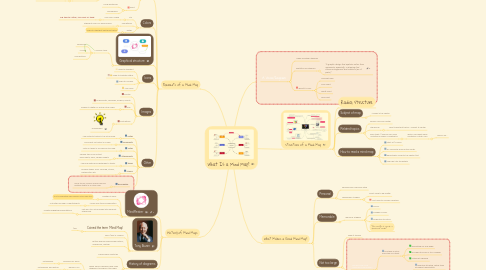
1. History of Mind Maps
1.1. MindMeister
1.1.1. Created in 2007
1.1.1.1. First completely web-based mind map tool
1.1.2. Allows real-time collaboration
1.1.2.1. Unlimited number of participants
1.1.3. Lets you turn mind maps into dynamic slideshows
1.1.3.1. Create engaging presentations
1.2. Tony Buzan
1.2.1. Coined the term 'Mind Map'
1.2.1.1. 1974
1.2.2. Born 1942 in London
1.2.3. British popular psychology author, researcher, adviser
1.3. History of diagrams
1.3.1. Traces back centuries
1.3.2. Many famous people have used diagrams throughout the ages
1.3.2.1. Porphyry of Tyros
1.3.2.1.1. Philosopher
1.3.2.2. Ramon Llull
1.3.2.2.1. Philosopher and author
1.3.2.3. Leonardo da Vinci
1.3.2.3.1. Polymath
2. Elements of a Mind Map
2.1. Text
2.1.1. Do
2.1.1.1. Keywords
2.1.1.2. Short phrases
2.1.1.3. Short sentences
2.1.1.3.1. Try to avoid
2.1.1.3.2. But allowed if necessary
2.1.2. Don't
2.1.2.1. Long sentences
2.1.2.2. Paragraphs
2.2. Colors
2.2.1. Tip
2.2.1.1. Use color codes!
2.2.1.1.1. e.g. Red for "Stop", "On Hold" or "Bad"
2.2.2. Sometimes
2.2.2.1. Different color for each branch
2.2.3. Often
2.2.3.1. Used to highlight individual topics
2.3. Graphical structure
2.3.1. Colorful lines
2.3.1.1. Branches
2.3.1.2. Arrows
2.3.1.3. Connections
2.4. Icons
2.4.1. Used to highlight
2.4.2. Used to indicate status
2.4.3. Used to number
2.4.4. And more
2.5. Images
2.5.1. Photos
2.5.2. Screenshots, Mockups, Graphs, Charts
2.5.3. Gifs
2.5.3.1. Embed in digital or online mind maps
2.5.4. Illustrations
2.5.4.1. Handdrawn
2.6. Other
2.6.1. Notes
2.6.1.1. Add notes to topics in the mind map
2.6.2. Comments
2.6.2.1. Comment on topics in a map
2.6.3. Votes
2.6.3.1. Vote on ideas in a shared mind map
2.6.4. Attachments
2.6.4.1. Upload files such as text documents, PDFs, spread sheets
2.6.5. Tasks
2.6.5.1. Add due dates and assignees to topics
2.6.6. Videos
2.6.6.1. Embed videos from YouTube, Vimeo, Dailymotion etc.
2.6.7. Boundaries
2.6.7.1. Use a visual, colorful frame around multiple topics in a mind map
3. A Visual Diagram
3.1. =Type of spider diagram
3.2. Definition of Diagram
3.2.1. "A graphic design that explains rather than represents; especially : a drawing that shows arrangement and relations (as of parts)"
3.3. What it is NOT
3.3.1. Concept map
3.3.2. Flow chart
3.3.3. Gantt chart
3.3.4. Org chart
4. Structure of a Mind Map
4.1. Radial structure
4.2. Subject of map
4.2.1. Always in the center
4.3. Related topics
4.3.1. Branch off from center
4.3.2. Hierarchy!
4.3.2.1. Most important topics = closest to center
4.3.3. Each topic / branch can have unlimited number of subtopics
4.3.3.1. Which can again have subtopics of their own
4.3.3.1.1. and so on...
4.4. How to read a mind map
4.4.1. Start at 1 o'clock
4.4.2. Go clockwise around the center
4.4.3. Read topics close to the center first
4.4.4. Then go into the details
5. What Makes a Good Mind Map?
5.1. Personal
5.1.1. Develop your personal style
5.1.2. Handdrawn images
5.1.2.1. Don't have to be pretty!
5.1.2.2. Just have to convey meaning
5.2. Memorable
5.2.1. Memory Triggers
5.2.1.1. Colors
5.2.1.2. Images & Icons
5.2.1.3. Graphical structure
5.2.1.4. "One image is worth a thousand words"
5.3. Not too large
5.3.1. Keep it simple!
5.3.2. Extract only most important information
5.3.2.1. Provides a quick overview of a topic
5.3.2.1.1. Everything on one page
5.3.2.1.2. No need to scroll or turn a page
5.3.2.1.3. Visible at a glance
5.3.2.2. Effective note taking
5.3.2.2.1. Requires thinking, rather than mindless transcription
5.3.2.2.2. Saves time
5.3.2.2.3. Notes are more memorable
5.3.2.2.4. Ideal for students!
